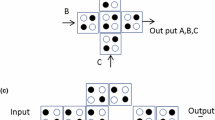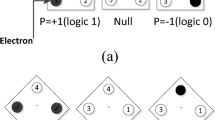Abstract
In this study, two new full adder/full subtractor designs based on quantum-dot cellular automata technology have been proposed. By means of the presented equation for SUM and SUBTRACT operations, the new high-speed, low power, and cost efficient designs have been achieved. Even if the three-level design has a lower cell count, occupies less area, and operates at a higher speed, the one-layer design is far more feasible. Analysis of the temperature and energy consumption of the proposed design indicates that the proposed approaches are superior to those of previous works.














Similar content being viewed by others
References
Ahmadpour S-S, Mosleh M (2018) A novel fault-tolerant multiplexer in quantum-dot cellular automata technology. J Supercomput 74(9):4696–4716
Abutaleb M (2018) Robust and efficient QCA cell-based nanostructures of elementary reversible logic gates. J Supercomput 74(11):6258–6274
Oskouei SM, Ghaffari A (2019) Designing a new reversible ALU by QCA for reducing occupation area. J Supercomput 75:5118–5144
Khosroshahy MB, Moaiyeri MH, Angizi S, Bagherzadeh N, Navi K (2017) Quantum-dot cellular automata circuits with reduced external fixed inputs. Microprocess Microsyst 50:154–163
Heikalabad SR, Asfestani MN, Hosseinzadeh M (2018) A full adder structure without cross-wiring in quantum-dot cellular automata with energy dissipation analysis. J Supercomput 74(5):1994–2005
Hashemi S, Azghadi MR, Navi K (2018) Design and analysis of efficient QCA reversible adders. J Supercomput 75:2106–2125
Wang L, Xie G (2018) Novel designs of full adder in quantum-dot cellular automata technology. J Supercomput 74(9):4798–4816
Mohammadi M, Mohammadi M, Gorgin S (2016) An efficient design of full adder in quantum-dot cellular automata (QCA) technology. Microelectron J 50:35–43
Balali M, Rezai A, Balali H, Rabiei F, Emadi S (2017) Towards coplanar quantum-dot cellular automata adders based on efficient three-input XOR gate. Results Phys 7:1389–1395
Sasamal TN, Singh AK, Mohan A (2016) An optimal design of full adder based on 5-input majority gate in coplanar quantum-dot cellular automata. Optik 127(20):8576–8591
Ahmad F, Bhat GM, Khademolhosseini H, Azimi S, Angizi S, Navi K (2016) Towards single layer quantum-dot cellular automata adders based on explicit interaction of cells. J Comput Sci 16:8–15
Mardiris VA, Karafyllidis IG (2010) Design and simulation of modular 2n to 1 quantum-dot cellular automata (QCA) multiplexers. Int J Circuit Theory Appl 38(8):771–785
Lakshmi SK, Athisha G, Karthikeyan M, Ganesh C (2010) Design of subtractor using nanotechnology based QCA. In: 2010 International Conference on Communication Control and Computing Technologies, 2010. IEEE, pp 384–388
Rad SK, Heikalabad SR (2017) Reversible flip-flops in quantum-dot cellular automata. Int J Theor Phys 56(9):2990–3004
Hashemi S, Navi K (2012) New robust QCA D flip flop and memory structures. Microelectron J 43(12):929–940
Kianpour M, Sabbaghi-Nadooshan R (2017) Novel 8-bit reversible full adder/subtractor using a QCA reversible gate. J Comput Electron 16(2):459–472
Taherkhani E, Moaiyeri MH, Angizi S (2017) Design of an ultra-efficient reversible full adder-subtractor in quantum-dot cellular automata. Optik 142:557–563
Kianpour M, Sabbaghi-Nadooshan R, Navi K (2014) A novel design of 8-bit adder/subtractor by quantum-dot cellular automata. J Comput Syst Sci 80(7):1404–1414
Gladshtein M (2013) Design and simulation of novel adder/subtractor on quantum-dot cellular automata: radical departure from Boolean logic circuits. Microelectron J 44(6):545–552
Barughi YZ, Heikalabad SR (2017) A three-layer full adder/subtractor structure in quantum-dot cellular automata. Int J Theor Phys 56(9):2848–2858
Hayati M, Rezaei A (2015) Design of novel efficient adder and subtractor for quantum-dot cellular automata. Int J Circuit Theory Appl 43(10):1446–1454
Abutaleb M (2017) A novel power-efficient high-speed clock management unit using quantum-dot cellular automata. J Nanopart Res 19(4):128
Kumar D, Mitra D, Bhattacharya BB (2017) on fault-tolerant design of exclusive-OR gates in QCA. J Comput Electron 16(3):896–906
Mohammadi Z, Mohammadi M (2014) implementing a one-bit reversible full adder using quantum-dot cellular automata. Quantum Inf Process 13(9):2127–2147
Das JC, De D (2017) Operational efficiency of novel SISO shift register under thermal randomness in quantum-dot cellular automata design. Microsyst Technol 23(9):4155–4168
Berarzadeh M, Mohammadyan S, Navi K, Bagherzadeh N (2017) A novel low power Exclusive-OR via cell level-based design function in quantum cellular automata. J Comput Electron 16(3):875–882
Pudi V, Sridharan K (2012) Low complexity design of ripple carry and Brent–Kung adders in QCA. IEEE Trans Nanotechnol 11(1):105–119
Sheikhfaal S, Angizi S, Sarmadi S, Moaiyeri MH, Sayedsalehi S (2015) Designing efficient QCA logical circuits with power dissipation analysis. Microelectron J 46(6):462–471
Angizi S, Moaiyeri MH, Farrokhi S, Navi K, Bagherzadeh N (2015) Designing quantum-dot cellular automata counters with energy consumption analysis. Microprocess Microsyst 39(7):512–520
Das JC, De D (2016) Novel low power reversible binary incrementer design using quantum-dot cellular automata. Microprocess Microsyst 42:10–23
Acknowledgements
The authors would like to thank Dr. Mona Moradi for her literature contribution.
Author information
Authors and Affiliations
Corresponding author
Additional information
Publisher's Note
Springer Nature remains neutral with regard to jurisdictional claims in published maps and institutional affiliations.
Rights and permissions
About this article
Cite this article
Sadeghi, M., Navi, K. & Dolatshahi, M. Novel efficient full adder and full subtractor designs in quantum cellular automata. J Supercomput 76, 2191–2205 (2020). https://doi.org/10.1007/s11227-019-03073-4
Published:
Issue Date:
DOI: https://doi.org/10.1007/s11227-019-03073-4




